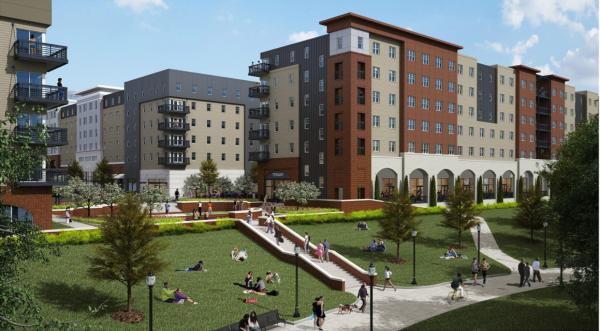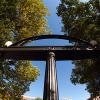Girtz: It's Hard to Legislate 'Funky' Development

Along Firefly Trail, the Selig development would look something like this, except with a less steep bike path.
Commissioner Kelly Girtz passed along some background information Sunday night on the Selig development. He intends to make a motion at Tuesday night's meeting to require Selig to include a bike path and a sidewalk connecting Firefly Trail to the UGA campus across Oconee Street.
While it doesn't include the flat rail spur that some believe has been reserved for a rail-trail link to campus, the path along Hickory Street extension would have a grade of no more than 5 percent. In a month or two, Selig would also have to come back to the commission for design approval for the plaza along the rail-trail.
Here's Girtz's commentary:
The Selig Project and Athens-Clarke County’s Role
The Selig Project scheduled for a vote regarding a Special Use permit on Tuesdayevening has generated an enormous amount of discussion in Athens, and in this piece, I will provide discussion of the Athens-Clarke County Commission’s role in this process, and respond to some related issues and concerns. The nature of this request, and guiding legal issues will be addressed, as well as big-picture questions about how we learn from the experience of this project. This will serve as the basis for some of my comments at Tuesday evening’s meeting of the Athens-Clarke County Mayor and Commission
The Framework
As in the case of the Selig submission, when citizens are interested in a proposed development project, dialogue often revolves around how significant a project will be to Athens and its future, and we are asked to make a careful decision. While it is absolutely true that we need to review each submission carefully, some of the most significant decisions have already been made. Policy that guides development is one of the major tasks of local government, and there are some significant code sections that come into play in this case.
In 1999 and 2000 the zoning and development codes for the county were significantly modified. It was decisions during this period that created the current zoning categories that exist today and related requirements. Among the key outcomes were the 10 acre minimum lot size in the “greenbelt”/Agricultural Zone, the 75 foot stream buffer ordinance, and the Commercial Downtown zoning category which allows for 200 bedrooms per acre. This is the offset of the demand for low density on the outskirts of the community; have people live in high density where resources, jobs, educational institutions, etc. are close at hand, thus requiring fewer and shorter car trips and ensuring the possibility of walking to destinations. Then, in 2007, enhanced design guidelines for downtown development (including the site in question) were approved, along with local historic protection for the core of downtown.
The very public processes that led to those and other codes in the past years and decades are the heart of the policymaking that underpins Selig’s submission, just as with every plan that is submitted to the county for consideration. All plans must be evaluated under the same set of criteria, as in accordance with the “rule of law” that serves as a foundation for our democracy.
A “Special Use” Request
Another key process in the case of the Selig submission is the nature of “Special Use” requests, which are distinct from rezoning requests. In both cases, a submission is first reviewed by Planning Staff, and submitted to the Planning Commission for a recommendation to the Mayor and Commission. In the case of a rezoning request in Georgia, a local elected body has wide latitude to require any number of plan modifications, or to reject a request outright because in a general way it is deemed inappropriate for the community. In contrast, a Special Use request is for specific deviations from code that are permissible if certain conditions apply. If these conditions cannot be met for applicable articulated cause, the request can be denied. If the conditions are met, an elected body cannot legally deny the request. In the case of the Selig Project, the “Special Use” request is for ground floor residential units along Wilkerson Street and a portion of the Rail-To-Trail (“Firefly”) corridor that would normally require commercial use (i.e. retail, restaurants, offices, etc.).
The critical language of the code asks to ensure that “the special use will have no greater adverse material effect on the livability of the impact area when compared to the development of the subject lot with the target use of the zone.” In this case, the question asked of the commission is to compare the “livability” of the area if there are ground-floor residential units on the Wilkerson and Rail-to-Trail frontage compared with commercial units in the same locations. The Wilkerson right-of-way is especially narrow, and the Trail frontage in question is the segment adjacent to the bridge that will fly over Wilkerson Street and the North Oconee River, so the replacement of commercial with residential units in those locations is justified, though introducing additional residential units does raise the question of how their tenants move through and around the site.
In the Commission-Defined Option that will be presented to the Mayor and Commission on Tuesday night, there will be a requirement that the Hickory Extension will accommodate bike travel via a two-way path of at least 10 feet in width between the pedestrian sidewalk and on street parking on the north and east sides of the two segments of the road with a path border that must be designed to protect the bike path from vehicular intrusion.
In addition, the bike trail approach adjacent to the plaza must meet the Firefly trail via a direct, continuous connection at least 10 feet wide that directly meets the finished elevation of the Firefly trail via no more than a 5% grade.
Finally, the boundary between the applicant’s property and the Athens-Clarke County Rail-Trail must be designed and returned to the Mayor and Commission for approval.
These three requirements will ensure greater comfort and aesthetic appeal for the residents of the units in question.
In addition, as an existing requirement from Planning Department staff, the Oconee Street frontage includes building footprints far enough from the existing street to allow for future right-of-way expansion in conjunction with the pending Corridor Plan for that road that has been underway for two years.
The Transportation Corridor Concept Map
There has been a considerable amount of attention given the Transportation Corridor Concept Map as it applies to the Selig project. This Map represents "concepts” for future transportation corridors in a general manner that must be built as parcels are developed, but not pre-engineered routes with specific coordinates and topographic certainties. Currently, there are two corridors identified that move through the Selig project – a Rail-to-Trail link, and an extension of Hickory Street, which currently terminates at East Broad Street. Both corridors are satisfied by the Hickory Street Extension with a separated bike path. The typical design for a Greenway Trail is a 14 foot wide shared by pedestrians, strollers, joggers, bikes, etc. In the design that will be forthcomingon Tuesday, with a 10 foot wide bike-only path in addition to a 10 foot sidewalk, the site will be more accommodating than the 14 foot path alone would be. Thus, no amendment to the Corridor Map is necessary for the A+D/Selig site.
There have been questions about what happens to both routes as one crosses Highway 78 into the UGA property, and whether the Corridor Map can continue to be satisfied. Given that the Georgia Department of Transportation requires that intersections form at a “T”, any road entering the UGA property would certainly enter across from Selig’s Oconee Street entry, which then might move in a variety of alignments.
Were there to be a bike route alone extending across Oconee Street/Hwy 78 in the location of the current Hodgson Oil Parking Lot (an approximately level former rail bed), as some have suggested, there would not be a traffic signal at what is a blind curve in the highway. If there was a road in that location with an adjacent trail, it would be a road to nowhere, given that it would route approximately to the sharp intersection of Mitchell and Thomas Streets very near a rail line (discussed below).
Since this southern segment traverses through as-yet undeveloped UGA property (currently, parking lots – which may not be built upon for years or decades), there is no means by which to dictate to the University exactly where future routes will go from its intersection with Oconee Street - just that they will exist, providing shorter block-lengths and an additional route into the eastern edge of campus.
My preferred option is that eventually there is a series of cuts between Oconee and Thomas Streets - one in alignment with the Hickory Extension (to Mitchell Street) that can bring vehicles to the back entrance of the Jackson Street deck, a bike/ped path along the Hodgson Oil Building, and even a third route aligned with Fulton Street. Insofar as any route will end up at the lower rear of the Jackson Street deck, far below the elevation of North Campus, the most significant thing about a routes south of 78 is providing multiple blocks for visual appeal and at least one additional access point; it would never serve as a wider "side door" taking you all the way to North Campus.
Whichever the ultimate alignments, both a ped/bike and vehicular route south of Highway 78 through the segment of campus opposite the Selig project are beneficial, so the Transportation Corridor Concept Map will continue to include both.
As significant to future movement through campus is future use of the rail line currently used solely by trains that occasionally transport coal to UGA’s boilers. This line has been long discussed as a prospective rail-with-trail route linking downtown via the Multimodal Center, East Campus (including the Georgia Museum of Art and Sanford Stadium), South Milledge Avenue (with nearby recreational fields and the State Botanical Gardens).
The Firefly Trail
There has been $12 million of public investment in the trail which currently marked by a trailhead on East Broad Street just below Hickory Street. This is the route that will travel over the North Oconee River, along the rail bed on the north side of Highway 78 and eventually to Winterville and points south. As noted above, there will be a requirement that Selig return to the Mayor and Commission with a design to be approved for the connection between their property and the Trail. Among the requests they have indicated that they will make is for a slope easement, so that a hill comes down from the edge of the structure in the place of what would otherwise be a retaining wall. The wall would certainly be unsightly, and a slope easement is preferred, but because the details of its design are important, we will ask that the property boundary be an appropriately designed space that serves as an attractive accompaniment to the trail. Given the width of land between the side of the planned structures and the trail itself, there will be no modification in the ability of the trail to follow the grade of the historic railbed. Similarly, no change in the Wilkerson Street/North Oconee River flyover will be permitted. Finally, as noted above, the connection between the Selig project and the Trail via the “plaza” area must be direct and comfortable.
Where do we go from here?
It could not be any clearer that July 2 is not just another night at City Hall, with another planning decision to be made. Obviously, we are talking about a project the size of two or three full blocks of our downtown cityscape. There are reasons to be very glad for the code changes of the last twenty years referenced early in this piece. An earlier iteration of the code would have allowed a development much like the one anchored by Academy Sports on Atlanta Highway, with front yard parking, disconnected outbuildings and myriad possible collisions between cyclists, pedestrians and motorists. We are fortunate that such a project is no longer possible on this site. Still, if I had to play amateur architect, I would certainly have designed elements of this differently. I would have left the structure that now houses the Jittery Joe’s Roaster and the adjacent painted brick cannery building. These could have served as anchors that reflect the former uses of the site and serve as a place from which the new components would pivot. Those are not questions that are able to be decided by the Mayor and Commission under existing code, though (recall that “rule of law” business).
One of the interesting things about our current downtown is the diversity of treatment for the exterior of structures – the cornices, the distinct materials, the decorative roof arches. It just takes a two minute stroll down Clayton or Broad or Washington Streets to admire the funky freshness of having a different aesthetic approach every thirty or forty feet. That’s what happens after 150 years of with structures constructed by a variety of builders when they change hands, go vacant, get renovated, and have a new business arriving every few years or decades.
As much as we like it funky in Athens, funky can seem hard to legislate. However, as policy makers we are compelled to think about the concrete, identifiable component details that lend this sense of place to our town. Current downtown design requirements that guide Selig building plans do call for a variety of materials to be used and modifications in the façade as you travel down a block. Looking at the plans, though, it cannot help but be obvious that this is one large project being constructed all at once, rather than via the slow series of parcel-by-parcel transitions that led to our current downtown fabric. Given this contrast, the Mayor and Commission owe it to everyone in town to look at the component details of our code to ask about these details: whether a greater variety of texture are necessary, whether block lengths should be more tightly managed, whether there should be an overall size limitation on individual uses, and whether there should be less uniformity in height for individual parcels of a certain size. These and other questions must be explored if we are to have the best possible code for future developments in Athens.












comments